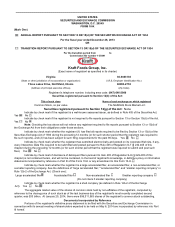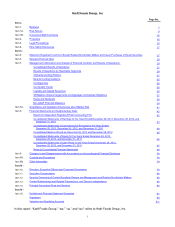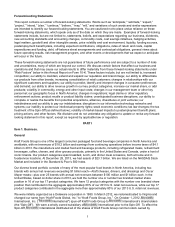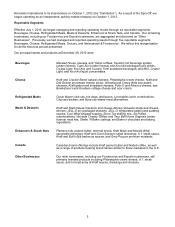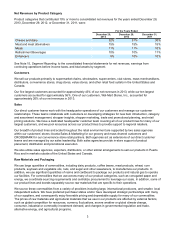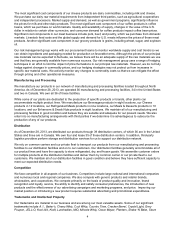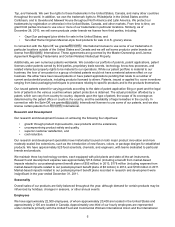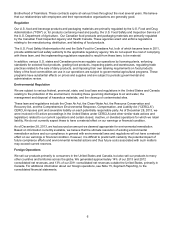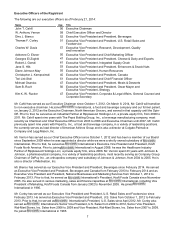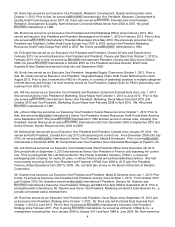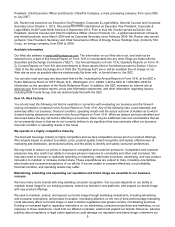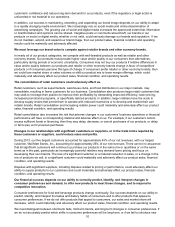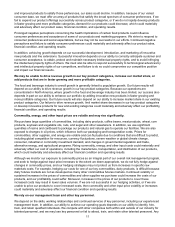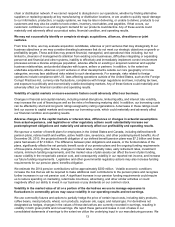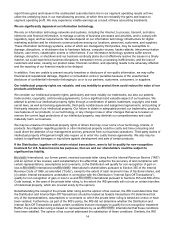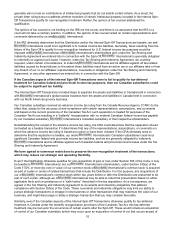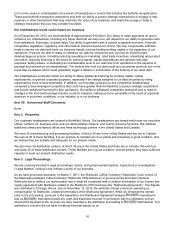Kraft 2013 Annual Report Download - page 8
Download and view the complete annual report
Please find page 8 of the 2013 Kraft annual report below. You can navigate through the pages in the report by either clicking on the pages listed below, or by using the keyword search tool below to find specific information within the annual report.6
Brotherhood of Teamsters. These contracts expire at various times throughout the next several years. We believe
that our relationships with employees and their representative organizations are generally good.
Regulation
Our U.S. food and beverage products and packaging materials are primarily regulated by the U.S. Food and Drug
Administration ("FDA") or, for products containing meat and poultry, the U.S. Food Safety and Inspection Service of
the U.S. Department of Agriculture. Our Canadian food products and packaging materials are primarily regulated
by the Canadian Food Inspection Agency and Health Canada. These agencies enact and enforce regulations
relating to the manufacturing, distribution, and labeling of food products.
The U.S. Food Safety Modernization Act and the Safe Food for Canadians Act, both of which became laws in 2011,
provide additional food safety authority to the applicable regulatory agency. We do not expect the cost of complying
with these laws, and the implementing regulations expected to result from these laws, to be material.
In addition, various U.S. states and Canadian provinces regulate our operations by licensing plants, enforcing
standards for selected food products, grading food products, inspecting plants and warehouses, regulating trade
practices related to the sale of dairy products, and imposing their own labeling requirements on food products.
Many of the food commodities we use in our operations are subject to governmental agricultural programs. These
programs have substantial effects on prices and supplies and are subject to periodic governmental and
administrative review.
Environmental Regulation
We are subject to various federal, provincial, state, and local laws and regulations in the United States and Canada
relating to the protection of the environment, including those governing discharges to air and water, the
management and disposal of hazardous materials, and the cleanup of contaminated sites.
These laws and regulations include the Clean Air Act, the Clean Water Act, the Resource Conservation and
Recovery Act, and the Comprehensive Environmental Response, Compensation, and Liability Act (“CERCLA”).
CERCLA imposes joint and severable liability on each potentially responsible party. As of December 28, 2013, we
were involved in 60 active proceedings in the United States under CERCLA (and other similar state actions and
legislation) related to our current operations and certain closed, inactive, or divested operations for which we retain
liability. We do not currently expect these to have a material effect on our earnings or financial condition.
As of December 28, 2013, we had accrued an amount we deemed appropriate for environmental remediation.
Based on information currently available, we believe that the ultimate resolution of existing environmental
remediation actions and our compliance in general with environmental laws and regulations will not have a material
effect on our earnings or financial condition. However, it is difficult to predict with certainty the potential impact of
future compliance efforts and environmental remedial actions and thus future costs associated with such matters
may exceed current reserves.
Foreign Operations
We sell our products primarily to consumers in the United States and Canada, but also sell our products to many
other countries and territories across the globe. We generated approximately 14% of our 2013 and 2012
consolidated net revenues, and 13% of our 2011 consolidated net revenues outside the United States, primarily in
Canada. For additional information about our foreign operations, see Note 15, Segment Reporting, to the
consolidated financial statements.

